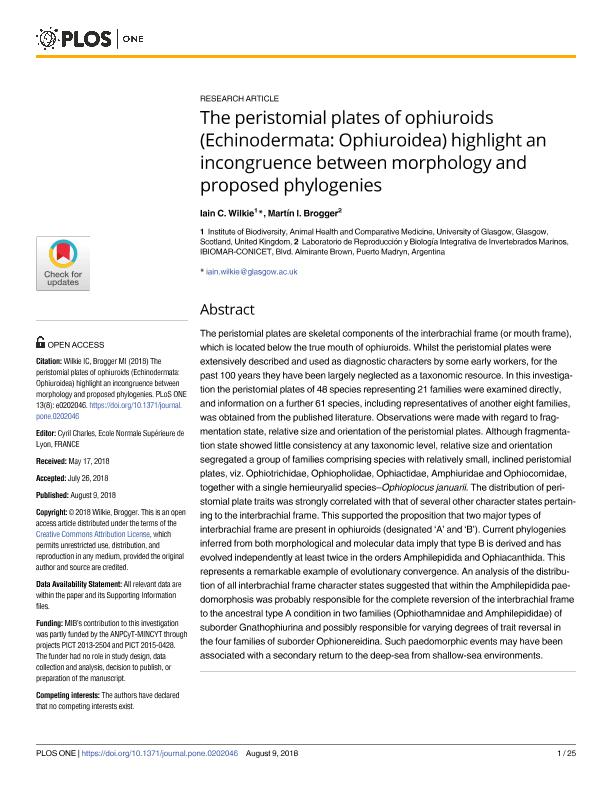Mostrar el registro sencillo del ítem
dc.contributor.author
Wilkie, Iain C.
dc.contributor.author
Brogger, Martin Ignacio

dc.date.available
2019-11-07T21:44:05Z
dc.date.issued
2018-08
dc.identifier.citation
Wilkie, Iain C.; Brogger, Martin Ignacio; The peristomial plates of ophiuroids (Echinodermata: Ophiuroidea) highlight an incongruence between morphology and proposed phylogenies; Public Library of Science; Plos One; 13; 8; 8-2018; 1-25; e0202046
dc.identifier.issn
1932-6203
dc.identifier.uri
http://hdl.handle.net/11336/88274
dc.description.abstract
The peristomial plates are skeletal components of the interbrachial frame (or mouth frame), which is located below the true mouth of ophiuroids. Whilst the peristomial plates were extensively described and used as diagnostic characters by some early workers, for the past 100 years they have been largely neglected as a taxonomic resource. In this investigation the peristomial plates of 48 species representing 21 families were examined directly, and information on a further 61 species, including representatives of another eight families, was obtained from the published literature. Observations were made with regard to fragmentation state, relative size and orientation of the peristomial plates. Although fragmentation state showed little consistency at any taxonomic level, relative size and orientation segregated a group of families comprising species with relatively small, inclined peristomial plates, viz. Ophiotrichidae, Ophiopholidae, Ophiactidae, Amphiuridae and Ophiocomidae, together with a single hemieuryalid species ? Ophioplocus januarii. The distribution of peristomial plate traits was strongly correlated with that of several other character states pertaining to the interbrachial frame. This supported the proposition that two major types of interbrachial frame are present in ophiuroids (designated ?A? and ?B?). Current phylogenies inferred from both morphological and molecular data imply that type B is derived and has evolved independently at least twice in the orders Amphilepidida and Ophiacanthida. This represents a remarkable example of evolutionary convergence. An analysis of the distribution of all interbrachial frame character states suggested that within the Amphilepidida paedomorphosis was probably responsible for the complete reversion of the interbrachial frame to the ancestral type A condition in two families (Ophiothamnidae and Amphilepididae) of suborder Gnathophiurina and possibly responsible for varying degrees of trait reversal in the four families of suborder Ophionereidina. Such paedomorphic events may have been associated with a secondary return to the deep-sea from shallow-sea environments.
dc.format
application/pdf
dc.language.iso
eng
dc.publisher
Public Library of Science

dc.rights
info:eu-repo/semantics/openAccess
dc.rights.uri
https://creativecommons.org/licenses/by-nc-sa/2.5/ar/
dc.subject
OPHIUROIDEA
dc.subject
ECHINODERMATA
dc.subject
PHYLOGENY
dc.subject
FUNCTIONAL MORPHOLOGY
dc.subject.classification
Zoología, Ornitología, Entomología, Etología

dc.subject.classification
Ciencias Biológicas

dc.subject.classification
CIENCIAS NATURALES Y EXACTAS

dc.title
The peristomial plates of ophiuroids (Echinodermata: Ophiuroidea) highlight an incongruence between morphology and proposed phylogenies
dc.type
info:eu-repo/semantics/article
dc.type
info:ar-repo/semantics/artículo
dc.type
info:eu-repo/semantics/publishedVersion
dc.date.updated
2019-10-22T15:55:02Z
dc.journal.volume
13
dc.journal.number
8
dc.journal.pagination
1-25; e0202046
dc.journal.pais
Estados Unidos

dc.journal.ciudad
San Francisco
dc.description.fil
Fil: Wilkie, Iain C.. University of Glasgow; Reino Unido
dc.description.fil
Fil: Brogger, Martin Ignacio. Consejo Nacional de Investigaciones Científicas y Técnicas. Centro Científico Tecnológico Conicet - Centro Nacional Patagónico. Instituto de Biología de Organismos Marinos; Argentina
dc.journal.title
Plos One

dc.relation.alternativeid
info:eu-repo/semantics/altIdentifier/doi/http://dx.doi.org/10.1371/journal.pone.0202046
dc.relation.alternativeid
info:eu-repo/semantics/altIdentifier/url/https://journals.plos.org/plosone/article?id=10.1371/journal.pone.0202046
Archivos asociados
